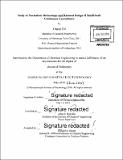| dc.contributor.advisor | Allan S. Myerson. | en_US |
| dc.contributor.author | Cui, Yuqing, Ph. D. Massachusetts Institute of Technology | en_US |
| dc.contributor.other | Massachusetts Institute of Technology. Department of Chemical Engineering. | en_US |
| dc.date.accessioned | 2016-09-13T19:11:53Z | |
| dc.date.available | 2016-09-13T19:11:53Z | |
| dc.date.copyright | 2016 | en_US |
| dc.date.issued | 2016 | en_US |
| dc.identifier.uri | http://hdl.handle.net/1721.1/104202 | |
| dc.description | Thesis: Ph. D., Massachusetts Institute of Technology, Department of Chemical Engineering, 2016. | en_US |
| dc.description | Cataloged from PDF version of thesis. | en_US |
| dc.description | Includes bibliographical references. | en_US |
| dc.description.abstract | Crystallization is a separation process widely used in several important industries such as food, pharmaceuticals, and specialty chemicals, where crystallization serves as the final step of purification and isolation. Crystallization is a two-step process: nucleation (birth of crystals) and crystal growth. Nucleation can occur via several mechanisms, and the most industrially relevant ones are heterogeneous nucleation (nucleation on a foreign surface), and contact secondary nucleation (nucleation from an existing crystal due to a contact force). Despite the importance of the nucleation process and decades of research, nucleation mechanisms remain enigmatic. This thesis advanced the understanding of the mechanisms of two types of nucleation: contact secondary nucleation, and contact-induced heterogeneous nucleation. By taking advantage of the thermodynamic and kinetic characteristics of glycine system, it is concluded that contact secondary nuclei could originate from both the semi-ordered solute molecules at the interface layer on the surface of existing crystals and directly from parent crystals themselves via the mechanism of micro-attrition depending on the magnitude of the contact force. The contact experiments on functionalized gold plates further confirmed that micro-attrition is not the exclusive mechanism for contact secondary nucleation-contact can induce nucleation even in the presence of only appropriate functional groups. For contact-induced heterogeneous nucleation, by relating nucleation frequency and polymorph with the strength and type of interactions between solute molecules and the templates, it is concluded that contact-induced heterogeneous nucleation share similarities with undisturbed heterogeneous nucleation in terms of attracting and stabilizing pre-nucleation clusters, but they are also fundamentally different in that crystals generated by the former are not chemically interacting with the templates. This thesis also describes the rational design of two small-scale continuous crystallizers, which are taking on increasingly important roles in the next-generation pharmaceutical manufacturing. The first design is a tubular crystallizer that generates crystals of narrow sizes through contact secondary nucleation. The second design is a multi-stage mixed-suspension mixed-product removal (MSMPR) system with a small footprint that works robustly at suspension handling. When optimizing this design with antisolvent crystallization, it was discovered that crystallization kinetic parameters are affected by antisolvent composition independent from supersaturation levels. This thesis highlights, for the first time, that optimizing continuous antisolvent crystallization in MSMPR crystallizers must take into account the effects of antisolvent composition on crystallization kinetics. | en_US |
| dc.description.statementofresponsibility | by Yuqing Cui. | en_US |
| dc.format.extent | 164 pages | en_US |
| dc.language.iso | eng | en_US |
| dc.publisher | Massachusetts Institute of Technology | en_US |
| dc.rights | M.I.T. theses are protected by copyright. They may be viewed from this source for any purpose, but reproduction or distribution in any format is prohibited without written permission. See provided URL for inquiries about permission. | en_US |
| dc.rights.uri | http://dspace.mit.edu/handle/1721.1/7582 | en_US |
| dc.subject | Chemical Engineering. | en_US |
| dc.title | Study of nucleation mechanisms and rational design of small-scale continuous crystallizers | en_US |
| dc.type | Thesis | en_US |
| dc.description.degree | Ph. D. | en_US |
| dc.contributor.department | Massachusetts Institute of Technology. Department of Chemical Engineering | |
| dc.identifier.oclc | 958137859 | en_US |
